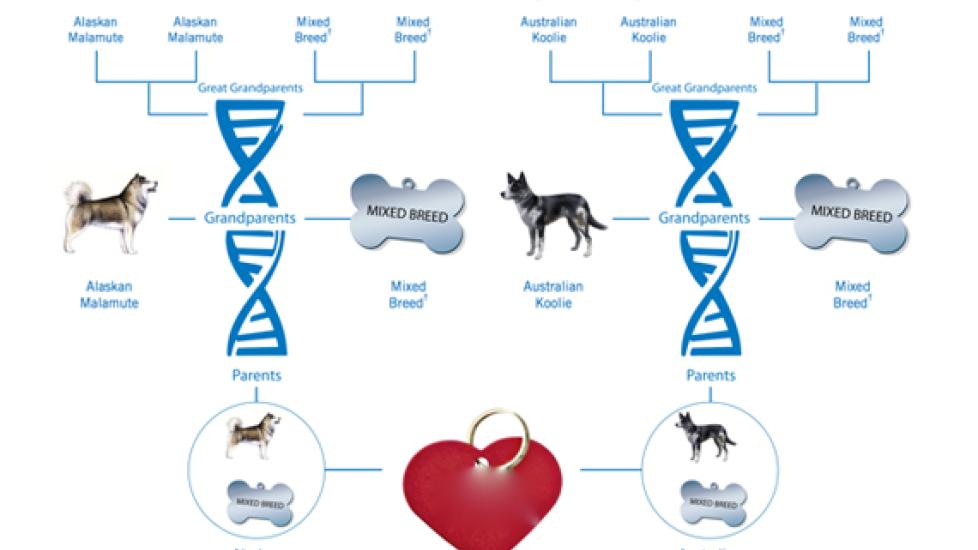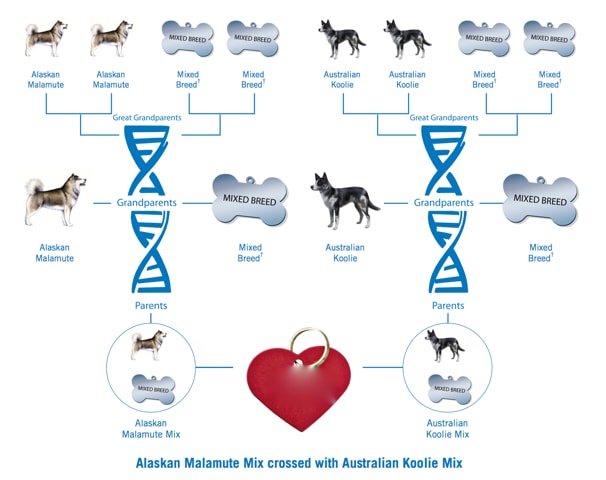What is the Value in Knowing which Mix of Breeds Make Up Your Mongrel?
In my years of veterinary practice, I haven’t felt an overwhelming urge to test my patients to determine the exact nature of their breed mix. Overall, I’ve not observed a trend where being of a specific breed designates an unwavering certainty that a particular illness will occur.
Instead, a stronger correlation seems to exist between a pet’s size (i.e., small, medium, large, and giant for dogs) and the potential for a certain disease to occur. For example, small dogs tend to have having poor periodontal health, while large dogs are commonly afflicted by orthopedic conditions.
Yet knowing my patients’ breed combinations can spur the awareness of unique disease conditions that are known to affect a particular breed. For example, herding breeds like the Australian Shepherd, Collie, Shetland Sheepdog, and others may have a defect in the multi-drug resistance gene (MDR1) which yields an increased likelihood that adverse reactions to medications may occur. What are these medications? Well, there’s quite a variety, including:
- Antiparasitics — ivermectin, milbemycin, etc.
- Antidiarrheals — loperamide (Immodium), etc.
- Anticancer agents — doxorubicin, vinctristine, etc.
Fortunately for the dogs that could be negatively impacted by the administration of these drugs, the Veterinary Clinical Pathology Lab at Washington State University offers a blood or cheek swab test to determine if a defect in the MDR1 gene exists.
Recently, I had a client seeking clarity on the mix of breeds that went into creating the composite that was her family’s new canine companion. From a standpoint of care provision, knowing if my patient had a defect in the MDR1 gene would lend valuable insight as to whether he could show an adverse reaction to the above mentioned drugs.
This was the first time I received such a request, so I pursued some guidance from experts at the Veterinary Information Network (VIN) as to their recommendation for a test that was touted to be the most reliable. Subsequently, I ordered a MARS Wisdom Panel Insights test and collected a sample from my patient.
Fortunately, just a small quantity of cells from the inside of a dog’s cheek is needed. Collection requires that either pet owner or care provider use the provided wire brush (like that used to clear a drainage pipe) to swab the inside of the patient’s cheek for a period of at least 30 seconds. In an impatient and squirmy puppy, this can present somewhat of a challenge.
Once our sample was collected, it was placed in a convenient postage-paid envelope and shipped back to the manufacturer. A few weeks later, we had our results.
There were a couple of breeds I had anticipated my patient being composed of; Australian Shepherd, Labrador Retriever, and Great Dane were on my list. Additionally, I suspected the Catahoula Leopard Dog (AKA Louisiana Cur) from the standpoint of the dog’s overall body composition and coat appearance.
According to MARS:
The Wisdom Panel® Insights computer algorithm performed over seven million calculations using 11 different models (from a single breed to complex combinations of breeds) to predict the most likely combination of pure and mixed breed dogs in the last 3 ancestral generations that best fit the DNA marker pattern observed in (my patient).
So, what did my patient turn out to be? It turns out he’s a blend of Alaskan Malamute mixed breed and Australian Koolie mixed breed. Further, his grandparents were also combinations of Alaskan Malamute mixed breed and Australian Koolie mixed breed.
There are some likely contenders making up the mixed breeds that contributed to the genetic material. The MARS report explained …
We have identified for you the 5 next best breed matches which appeared in the analysis of your dog's DNA. One or more of these breeds could have contributed to the genetic makeup of the ancestors indicated by the mixed breed icon. The breeds are listed by the relative strength of each result in our analysis with the most likely at the top of the list. There could also be a breed or breeds present in the mixed breed component that we cannot detect with our current database of purebred dogs.
So, my patient’s top five include:
1. Finnish Spitz, 8.33%
2. Golden Retriever, 7.77%
3. German Shepherd Dog, 7.27%
4. Afghan Hound, 4.85%
5. Catahoula Leopard Dog, 3.16%
So he is part Catahola Leopard Dog after all. At least his mix of breeds does not put him on the list of candidates potentially suffering health problems as a result of the MDR1 gene defect.
What do you think about genetic testing to determine what breeds compose a mixed breed dog?
The results of my patient's Wisdom genetic panel (click image to enlarge)

Dr. Patrick Mahaney

